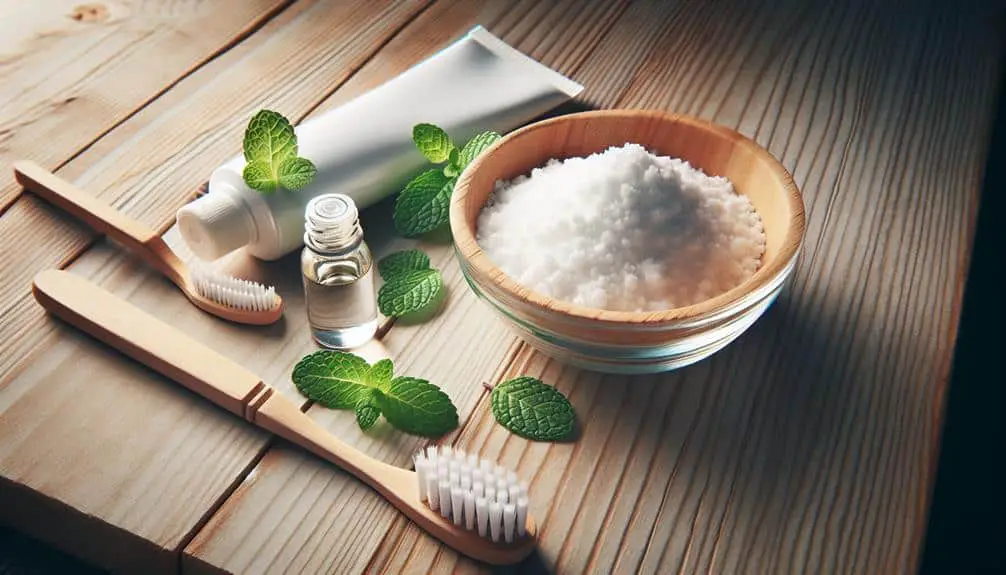Achieve a brighter smile by making your own DIY toothpaste with the whitening benefits of baking soda. Mix baking soda and water to create a paste, then add flavor with essential oils like peppermint or cinnamon. Store it in a container, and apply a small amount to your toothbrush, brushing gently in circular motions. For best results, use this toothpaste 2-3 times a week and remember to protect your enamel by avoiding excessive abrasion.
Using baking soda toothpaste alternately with fluoride ones can maintain good oral hygiene. Take care, as excessive use may erode enamel, especially if you have sensitive teeth. Master the art of natural tooth whitening with this simple, effective DIY recipe.
Key Points
- Baking soda is a gentle abrasive for effective stain removal.
- Coconut oil adds antimicrobial benefits to the toothpaste.
- Peppermint oil provides flavor and potential antibacterial properties.
- Use essential oils like cinnamon for added taste and oral health benefits.
- Brush gently with baking soda toothpaste 2-3 times a week for best results.
Benefits of Baking Soda Toothpaste
When used correctly, baking soda toothpaste can effectively remove surface stains and help brighten your smile. Natural alternatives like baking soda have gained popularity in dental care due to their oral health benefits. Baking soda is a mild abrasive that can gently scrub away plaque and stains from the surface of your teeth without causing damage to the enamel. Its alkaline nature also helps neutralize acids in the mouth, reducing the risk of tooth decay and gum disease.
Studies have shown that toothpaste containing baking soda can be as effective as commercial whitening toothpaste in removing stains and whitening teeth. Additionally, baking soda has antimicrobial properties that can help in reducing bacteria in the mouth, leading to fresher breath and a healthier oral environment. By incorporating baking soda toothpaste into your oral hygiene routine, you can enjoy the benefits of a natural alternative that promotes both oral health and a brighter smile.
Ingredients Needed for DIY Toothpaste
To create your own DIY toothpaste with baking soda for whitening, gather the following ingredients. When opting for natural alternatives, consider using baking soda as the base ingredient. Baking soda is known for its mild abrasive properties that help remove surface stains on teeth, making it a popular choice for homemade toothpaste.
In addition to baking soda, you'll need coconut oil, which has antimicrobial properties that can promote oral health. Coconut oil also helps in achieving a paste-like consistency for the toothpaste.
For flavor options, peppermint essential oil is a common choice due to its invigorating taste and potential antibacterial properties. Peppermint oil can leave your mouth feeling clean and your breath fresh. If you prefer a different flavor, you can explore alternatives such as cinnamon or spearmint essential oils. These oils not only add a pleasant taste but also offer potential benefits for oral health.
Steps to Make Baking Soda Toothpaste
Consider the following simple steps to create your own effective baking soda toothpaste at home.
- Mixing Ingredients: Begin by combining baking soda and a small amount of water in a bowl until it forms a paste-like consistency.
- Adding Flavor: Incorporate a few drops of peppermint oil or a sprinkle of cinnamon to enhance the taste and freshen your breath.
- Storing Properly: Transfer the toothpaste into a sealable container to keep it fresh and prevent it from drying out.
- Application Techniques: Apply a small amount of the toothpaste to your toothbrush and brush your teeth gently in circular motions to avoid damaging your enamel.
When making your baking soda toothpaste, make sure you follow the steps diligently for the best results.
Once your toothpaste is ready, keep in mind that brushing frequency is key to maintaining good oral hygiene. Brushing twice a day, especially after meals, is recommended to keep your teeth clean and healthy.
Tips for Using Baking Soda Toothpaste
For optimal results, make sure to apply a small amount of baking soda toothpaste to your toothbrush and brush your teeth gently in circular motions to protect your enamel. Brushing technique is key when using baking soda toothpaste. The gentle circular motions help to effectively remove plaque and stains without being too abrasive on your teeth. Make certain that you cover all surfaces of your teeth for a thorough clean.
In terms of frequency of use, it's recommended to use baking soda toothpaste 2-3 times a week to avoid excessive abrasion on your enamel. While baking soda is a potent ingredient for whitening, using it too frequently can wear down the enamel over time. Alternating with a regular fluoride toothpaste can help maintain the health of your teeth while still benefiting from the whitening properties of baking soda.
Precautions When Whitening With Baking Soda
When whitening your teeth with baking soda, it's important to be mindful of potential risks to your enamel and overall oral health. Baking soda can be abrasive, so it's essential to take precautions to protect your teeth. Here are some key points to keep in mind:
- Oral Health: While baking soda can help whiten teeth, excessive use may lead to enamel erosion, causing sensitivity and other oral health issues.
- Sensitivity: Individuals with sensitive teeth should be cautious when using baking soda, as it may worsen sensitivity over time.
- Tooth Enamel: The abrasive nature of baking soda can wear down tooth enamel if used too aggressively or too frequently.
- Abrasion: To prevent enamel abrasion, it's recommended to use baking soda toothpaste in moderation and follow up with a fluoride toothpaste to remineralize the teeth.
Frequently Asked Questions
Can Baking Soda Toothpaste Be Used on Sensitive Teeth?
If you experience sensitivity, using a baking soda toothpaste may not be ideal. Opt for toothpaste designed for sensitivity management with ingredients like potassium nitrate. Alternatives to baking soda toothpaste include fluoride toothpaste for gentle whitening.
How Often Should I Use Baking Soda Toothpaste for Whitening?
For ideal whitening benefits, consider using baking soda toothpaste 2-3 times a week. Overuse can lead to enamel damage, so moderation is key. Strike a balance for a brighter smile without risking sensitivity.
Can Baking Soda Toothpaste Replace Regular Toothpaste in My Dental Routine?
You can use baking soda alternatives occasionally, but it's not recommended to replace regular toothpaste entirely. Toothpaste ingredients like fluoride provide additional benefits for your oral health that baking soda alone may not offer.
Will Baking Soda Toothpaste Help With Bad Breath?
When it comes to oral hygiene and fresh breath, baking soda toothpaste can be a natural remedy. Baking soda benefits include neutralizing acids and fighting bacteria, aiding in combating bad breath. Incorporate it into your routine for a minty freshness.
Can Children Use Baking Soda Toothpaste for Whitening?
Children's dental care is essential. Baking soda toothpaste for whitening isn't recommended due to its abrasiveness. Opt for gentle toothpaste specially formulated for kids. Safety is key. Prioritize their oral health with suitable alternatives.




